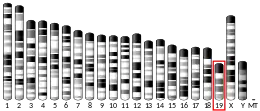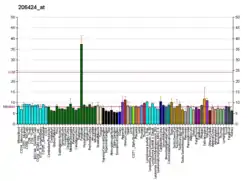Cytochrome P450 26A1 is a protein that in humans is encoded by the CYP26A1 gene.[5][6][7]
Function
This gene encodes a member of the cytochrome P450 superfamily of enzymes. The cytochrome P450 proteins are monooxygenases which catalyze many reactions involved in drug metabolism and synthesis of cholesterol, steroids and other lipids. This endoplasmic reticulum protein acts on retinoids, including all-trans-retinoic acid (RA), with both 4-hydroxylation and 18-hydroxylation activities. This enzyme regulates the cellular level of retinoic acid which is involved in regulation of gene expression in both embryonic and adult tissues. Two alternatively spliced transcript variants of this gene, which encode the distinct isoforms, have been reported.[7]
CYP26A1 is over-expressed in colorectal cancer cells compared to normal colonic epithelium but is of no independent prognostic value in patients with colorectal cancer.[8]
References
- 1 2 3 GRCh38: Ensembl release 89: ENSG00000095596 - Ensembl, May 2017
- 1 2 3 GRCm38: Ensembl release 89: ENSMUSG00000024987 - Ensembl, May 2017
- ↑ "Human PubMed Reference:". National Center for Biotechnology Information, U.S. National Library of Medicine.
- ↑ "Mouse PubMed Reference:". National Center for Biotechnology Information, U.S. National Library of Medicine.
- ↑ White JA, Beckett-Jones B, Guo YD, Dilworth FJ, Bonasoro J, Jones G, Petkovich M (July 1997). "cDNA cloning of human retinoic acid-metabolizing enzyme (hP450RAI) identifies a novel family of cytochromes P450". The Journal of Biological Chemistry. 272 (30): 18538–41. doi:10.1074/jbc.272.30.18538. PMID 9228017.
- ↑ White JA, Beckett B, Scherer SW, Herbrick JA, Petkovich M (March 1998). "P450RAI (CYP26A1) maps to human chromosome 10q23-q24 and mouse chromosome 19C2-3". Genomics. 48 (2): 270–2. doi:10.1006/geno.1997.5157. PMID 9521883.
- 1 2 "Entrez Gene: CYP26A1 cytochrome P450, family 26, subfamily A, polypeptide 1".
- ↑ Brown GT, Cash BG, Blihoghe D, Johansson P, Alnabulsi A, Murray GI (2014-03-07). "The expression and prognostic significance of retinoic acid metabolising enzymes in colorectal cancer". PLOS ONE. 9 (3): e90776. Bibcode:2014PLoSO...990776B. doi:10.1371/journal.pone.0090776. PMC 3946526. PMID 24608339.
External links
- Human CYP26A1 genome location and CYP26A1 gene details page in the UCSC Genome Browser.
Further reading
- Duell EA, Kang S, Voorhees JJ (February 1996). "Retinoic acid isomers applied to human skin in vivo each induce a 4-hydroxylase that inactivates only trans retinoic acid". The Journal of Investigative Dermatology. 106 (2): 316–20. doi:10.1111/1523-1747.ep12342972. PMID 8601734.
- Ray WJ, Bain G, Yao M, Gottlieb DI (July 1997). "CYP26, a novel mammalian cytochrome P450, is induced by retinoic acid and defines a new family". The Journal of Biological Chemistry. 272 (30): 18702–8. doi:10.1074/jbc.272.30.18702. PMID 9228041.
- Sonneveld E, van den Brink CE, van der Leede BM, Schulkes RK, Petkovich M, van der Burg B, van der Saag PT (August 1998). "Human retinoic acid (RA) 4-hydroxylase (CYP26) is highly specific for all-trans-RA and can be induced through RA receptors in human breast and colon carcinoma cells". Cell Growth & Differentiation. 9 (8): 629–37. PMID 9716180.
- Trofimova-Griffin ME, Juchau MR (November 1998). "Expression of cytochrome P450RAI (CYP26) in human fetal hepatic and cephalic tissues". Biochemical and Biophysical Research Communications. 252 (2): 487–91. doi:10.1006/bbrc.1998.9659. PMID 9826557.
- Popa C, Dicker AJ, Dahler AL, Saunders NA (September 1999). "Cytochrome P450, CYP26AI, is expressed at low levels in human epidermal keratinocytes and is not retinoic acid-inducible". The British Journal of Dermatology. 141 (3): 460–8. doi:10.1046/j.1365-2133.1999.03039.x. PMID 10583049. S2CID 19697736.
- McSorley LC, Daly AK (August 2000). "Identification of human cytochrome P450 isoforms that contribute to all-trans-retinoic acid 4-hydroxylation". Biochemical Pharmacology. 60 (4): 517–26. doi:10.1016/S0006-2952(00)00356-7. PMID 10874126.
- Loudig O, Babichuk C, White J, Abu-Abed S, Mueller C, Petkovich M (September 2000). "Cytochrome P450RAI(CYP26) promoter: a distinct composite retinoic acid response element underlies the complex regulation of retinoic acid metabolism". Molecular Endocrinology. 14 (9): 1483–97. doi:10.1210/mend.14.9.0518. PMID 10976925.
- Deng L, Shipley GL, Loose-Mitchell DS, Stancel GM, Broaddus R, Pickar JH, Davies PJ (May 2003). "Coordinate regulation of the production and signaling of retinoic acid by estrogen in the human endometrium". The Journal of Clinical Endocrinology and Metabolism. 88 (5): 2157–63. doi:10.1210/jc.2002-021844. PMID 12727970.
- Won JY, Nam EC, Yoo SJ, Kwon HJ, Um SJ, Han HS, Kim SH, Byun Y, Kim SY (August 2004). "The effect of cellular retinoic acid binding protein-I expression on the CYP26-mediated catabolism of all-trans retinoic acid and cell proliferation in head and neck squamous cell carcinoma". Metabolism. 53 (8): 1007–12. doi:10.1016/j.metabol.2003.12.015. PMID 15281009.
- Loudig O, Maclean GA, Dore NL, Luu L, Petkovich M (November 2005). "Transcriptional co-operativity between distant retinoic acid response elements in regulation of Cyp26A1 inducibility". The Biochemical Journal. 392 (Pt 1): 241–8. doi:10.1042/BJ20050874. PMC 1317683. PMID 16053444.
- Ozpolat B, Mehta K, Lopez-Berestein G (October 2005). "Regulation of a highly specific retinoic acid-4-hydroxylase (CYP26A1) enzyme and all-trans-retinoic acid metabolism in human intestinal, liver, endothelial, and acute promyelocytic leukemia cells". Leukemia & Lymphoma. 46 (10): 1497–506. doi:10.1080/10428190500174737. PMID 16194896. S2CID 12269201.
- Heise R, Mey J, Neis MM, Marquardt Y, Joussen S, Ott H, Wiederholt T, Kurschat P, Megahed M, Bickers DR, Merk HF, Baron JM (November 2006). "Skin retinoid concentrations are modulated by CYP26AI expression restricted to basal keratinocytes in normal human skin and differentiated 3D skin models". The Journal of Investigative Dermatology. 126 (11): 2473–80. doi:10.1038/sj.jid.5700432. PMID 16778795.
- Rat E, Billaut-Laden I, Allorge D, Lo-Guidice JM, Tellier M, Cauffiez C, Jonckheere N, van Seuningen I, Lhermitte M, Romano A, Guéant JL, Broly F (June 2006). "Evidence for a functional genetic polymorphism of the human retinoic acid-metabolizing enzyme CYP26A1, an enzyme that may be involved in spina bifida". Birth Defects Research. Part A, Clinical and Molecular Teratology. 76 (6): 491–8. doi:10.1002/bdra.20275. PMID 16933217.
- Gomaa MS, Yee SW, Milbourne CE, Barbera MC, Simons C, Brancale A (August 2006). "Homology model of human retinoic acid metabolising enzyme cytochrome P450 26A1 (CYP26A1): active site architecture and ligand binding". Journal of Enzyme Inhibition and Medicinal Chemistry. 21 (4): 361–9. doi:10.1080/14756360600742014. PMID 17059167. S2CID 20519075.
- Quere R, Baudet A, Cassinat B, Bertrand G, Marti J, Manchon L, Piquemal D, Chomienne C, Commes T (May 2007). "Pharmacogenomic analysis of acute promyelocytic leukemia cells highlights CYP26 cytochrome metabolism in differential all-trans retinoic acid sensitivity". Blood. 109 (10): 4450–60. doi:10.1182/blood-2006-10-051086. PMID 17218384. S2CID 1494837.
- Lee SJ, Perera L, Coulter SJ, Mohrenweiser HW, Jetten A, Goldstein JA (March 2007). "The discovery of new coding alleles of human CYP26A1 that are potentially defective in the metabolism of all-trans retinoic acid and their assessment in a recombinant cDNA expression system". Pharmacogenetics and Genomics. 17 (3): 169–80. doi:10.1097/FPC.0b013e32801152d6. PMC 2393551. PMID 17460545.




